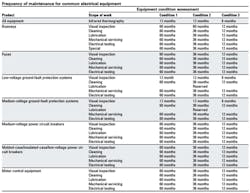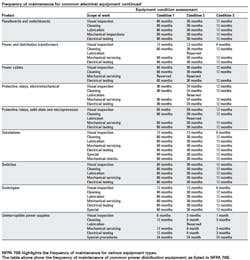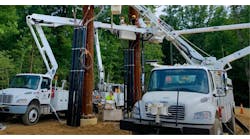When we think about maintenance of electrical equipment, we don’t quickly make the connection to power quality. However, many issues that affect quality and performance can be traced back to poor, or a total lack of, routine maintenance. Loose connections can cause flickers, overheating, etc. High impedance ground connections (due to corrosion and other factors) can cause excessive flow of current on the neutral along with increased risk of injury during faults, along with nuisance trips of ground fault equipment.
In 2023, the industry guideline that covers electrical equipment maintenance has been revised significantly since it was first printed 50 years ago in 1973. The former Recommended Practice for Electrical Equipment Maintenance to the Standard for Electrical Equipment Maintenance has now become the Standard for Electrical Equipment Maintenance (NFPA 70B), effective January 16, 2023, when it was approved as an American National Standard by the American National Standards Institute (ANSI).
The 2023 version of NFPA 70B, now a standard, shifts from recommendations to mandatory language surrounding the implementation of electrical maintenance programs. Earlier versions of NFPA 70B provide for what electrical maintenance practices “should” be, whereas the new version provides for what they “shall” be. Changes were made to incorporate the electrical equipment’s physical condition, criticality, and operating environment when determining the frequency of maintenance. The failure of improperly maintained equipment could impact personnel or environmental safety.
NFPA 70B 2023 Chapter 9 prescribes maintenance intervals based on an equipment condition assessment (ECA), which depends on the following minimum conditions:
- Equipment physical condition
- Criticality
- Operating environment
The ECA is driven by the highest value of these three conditions.
For example, if the equipment is designated “Condition 1” for electrical equipment and criticality, but “Condition 3” for the operating environment, then the equipment would use “Condition 3” durations for the ECA maintenance intervals. NFPA 70B 2023 also requires a decal system after maintenance to provide a visual indication for electrical workers of the electrical equipment condition of maintenance.
Condition 1 (NFPA 70B 2023 Sec. 9.3.1.1)
Equipment that fits into this category is "like new," and maintenance has been performed per the EMP.
Condition 2 (NFPA 70B 2023 Sec. 9.3.1.2)
Equipment that fits into this category means the maintenance results deviate from past results, or some issues require repair or replacement of components. When your equipment reaches this condition, it is recommended that you partner with a reliable and professional testing provider to ensure any deficiencies are identified and addressed so your equipment can return to the "like new" status of Condition 1.
Condition 3 (NFPA 70B 2023 Sec. 9.3.1.3)
Equipment that fits into this category has either missed maintenance cycles under the EMP, the previous two cycles have revealed issues requiring repair, or action is needed based on continuous monitoring system notifications or other predictive techniques. The standard also provides instructions regarding how to assign a ‘criticality condition’ and ‘operating environment condition’ to equipment.
NFPA 70B 2023 now includes a new chapter identifying the required frequency of maintenance for electrical equipment (see Tables below). ‘Maintenance interval’ (see Sec. 3.3.37) is defined as: “The frequency of inspecting, testing, monitoring, analyzing, and servicing electrical equipment that is determined by the type, criticality, and condition of the equipment.”
The best way to ensure the highest level of system reliability, electrical equipment up-time and minimizing power quality issues due to lack of maintenance is to have an electrical maintenance program (EMP). With this new standard, a specific EMP is required.
If you already have an EMP, updating your program is critical to ensure you are compliant. NFPA 70B 2023 Chapter 4 provides new details and requirements for the development and execution of an EMP. It is now required that it shall include (per Sec. 4.2.4.2):
- An electrical safety program that addresses the condition of maintenance.
- Identification of personnel responsible for implementing each element of the program.
- Survey and analysis of electrical equipment and systems to determine maintenance requirements and priorities .
- Developed and documented maintenance procedures for equipment.
- A plan of inspections, servicing, and suitable tests.
- A maintenance, equipment, and personnel documentation and records-retention policy.
- A process to prescribe, implement, and document corrective measures based on collected data.
- A process for incorporating design for maintainability in electrical installations.
- A program review and revision process that considers failures and findings for continuous improvement.
Without question, electrical equipment that has not been maintained properly or is not functioning properly poses a significant additional risk to those who are working on that equipment and its associated systems. NFPA 70E states that we must address and consider conditions of maintenance for applications (e.g., estimating the likelihood of severity in both shock risk and arc flash risk assessments).
NFPA 70B is the standard that can now be both utilized and enforced to ensure that the proper conditions of maintenance have been established.
David Colombo, P.E. is a professional engineer located in Massachusetts, and the owner and principal of Power Engineers, LLC, a design, engineering, and consulting firm. He has more than 30 years in the electrical engineering and construction industry and is involved with the design of utility substation & distribution infrastructure, large-scale renewable energy projects, and commercial / industrial power systems. He specializes in the areas of medium-voltage design, power distribution, protection, metering, power quality, power studies, and arc flash analysis. He also provides owner’s engineering support for developers, EPC contractors, and project owners. Prior to starting Power Engineers, LLC and being an engineering consultant, he was a utility distribution supervising engineer. He holds a bachelor of science degree in electrical engineering from Worcester Polytechnic Institute (WPI) and a master of engineering degree in electric power engineering from Rensselaer Polytechnic Institute (RPI). He is a registered professional engineer in 13 states.






